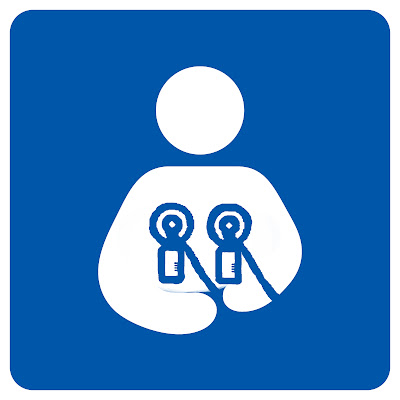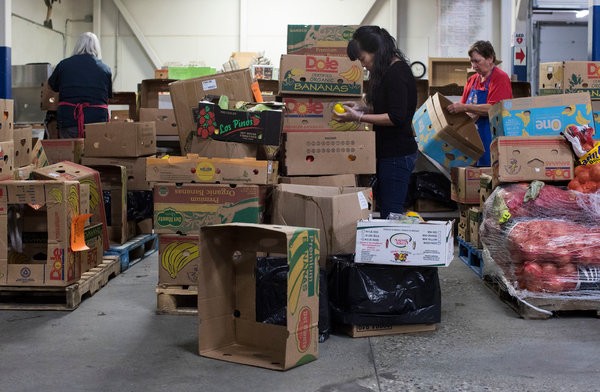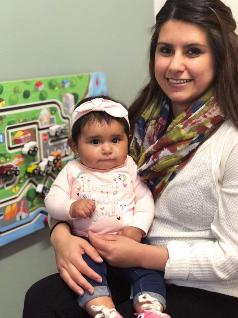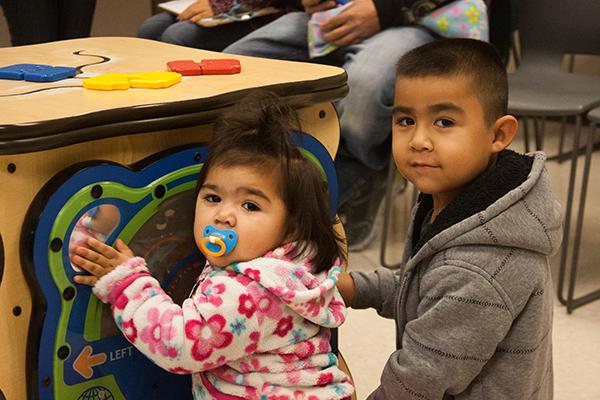|
May: Oral Health Month
Tooth decay is a common but often preventable problem. Untreated tooth decay is progressive and can undermine children's long-term health, educational achievements, self-image, and overall success. In addition, oral health during pregnancy can have long-term effects on children. Good news: WIC Can Help promote oral health for families by referring them to low-cost or free services.
|

WIC Worksite Wellness Tips!
If you weren't able to join us for our annual conference in San Diego, you can still get some tips on best practices for WIC Worksite Wellness! Check out the slides and accompanying worksheet!
|
Shopping at Amazon?
Support CWA without spending anything extra by using
AmazonSmile!
|
Did someone share this with you? Sign up here to get the CWA Flash directly!
|
|
|

ACT NOW to Help Medi-Cal Participants Access High-Quality Breast Pumps!
Medi-Cal reimbursement rates for breastfeeding support have not increased since 1998, making it difficult for Medi-Cal participants to access high quality breast pumps. Low quality breast pumps may yield little or no milk, preventing mothers from establishing or maintaining breastfeeding, impacting their baby's feeding - and ultimately overall health. Lack of quality breast pumps through Medi-Cal has forced new mothers to search for alternative providers, such as WIC, to cover gaps in breast pump supplies, or to give up on meeting their breastfeeding goals. CWA has proposed a modest proposal for as little as 1.2 million annually to increase in the Medi-Cal breastfeeding support budget will help ensure all mothers have the opportunity to successfully breastfeed their babies using effective breast pumps, saving Medi-Cal costs in the long run. ACTION: Read the recent article from Capitol Public Radio. Call the Senate and Assembly Budget Sub-Committee members to let them know that Medi-Cal participants deserve equal access to high-quality breast pumps!
|

State Budget Has Many Asks
With a surplus again this year, there are many worthy budget proposals. Governor Newsom has been very visible in addressing a number of major issues, while also protecting the rainy day fund and paying down debt. His top line asks include health care access, childcare and early education and housing. Assembly and Senate members have also put forward a number of asks, as have stakeholders. Last week the Governor's revised May budget was released and the CA Budget & Policy Center provides a first look. By mid-June the budget proposals for each house will be trimmed, conferenced between the houses with leaders from each house making the final decisions, with the goal of a budget by July 1. CWA (Medi-Cal reimbursement increase for breastpumps), Heluna Health-parent organization to PHFE (funding for Little by Little early literacy), and the Children's Partnership (expedited enrollment for WIC and Medi-Cal), CA Food Policy Advocates (child nutrition funding) all have budget proposals, as stakeholders, that would directly impact WIC participants. Expect the next 5 weeks to include many budget updates.
|

Proposed Changes to Federal Poverty Measure
A change in the methodology for calculating the Official Poverty Measure (OPM) is being proposed by the Office of Management and Budget. A number of consumer price and inflation indexes are used for different consumer groups. The consumer price index (CPI) is currently used to define poverty measures and eligibility for different benefits, with the proposal to change to the more recently developed Chained CPI (C-CPI). The C-CPI adjusts for inflation, as consumer behavior changes, based on economic shifts. The proposal is not new, having been brought forward in 2013 in relation to Social Security and the tax code. For public benefits, use of the C-CPI would raise the poverty threshold and make ineligible for benefits, many individuals receiving Medicaid, SNAP or WIC.
|

New HUD Proposal Would Harm Immigrant Families
Thousands of legal residents and citizens, including 55,000 children who are in the country legally, could be displaced under a proposed rule intended to prevent undocumented immigrants from receiving federal housing assistance, according to the Department of Housing and Urban Development. The proposal, published last week, would prohibit families in which at least one member is undocumented from obtaining subsidized housing, according to an analysis by HUD career officials. The administration is pushing the changes to ensure that the benefits are awarded only to verified citizens - a move that was made without the knowledge of many longtime housing officials at the department. Current rules bar undocumented immigrants from receiving federal housing subsidies, but allow families of mixed immigration status to live in subsidized housing as long as one household member is a legal resident. The subsidies are prorated based on the number of eligible members of the family. According to the HUD analysis, more than 108,000 people receiving benefits are in a household with at least one undocumented immigrant. Under the proposed rule, families of mixed status would no longer be permitted to live in public housing. Members who are in the country legally would be allowed to stay in their home, but the analysis found that they would be unlikely to do so: The fear of a family separation alone - and displacing one or both of a child's parents or guardians - would have the effect of driving the entire family, including children, to vacate. ACTION: The National Housing Law Project (NHLP) and National Low Income Housing Coalition (NLIHC) are leading the effort to oppose this harmful proposal and have developed advocacy tools for you to use to join us in opposition. Together, NHLP and NLIHC launched a new website, www.Keep-Families-Together.org, where you can find a fact sheet, talking points, and social media images, read the latest news, and submit your own comments directly to HUD by JULY 9th. NHLP and NLIHC will also host a Twitterstorm on Thursday, May 16 at 3:00pm ET/2:00pm CT/12:00pm PT.
|
|
|
 |
We Rode the Wave in San Diego!
We had a great time with everyone who was able to come to the conference. That agenda was great, right? The trade show was busy and there were lots of opportunities to learn about WIC WISE, EBT and talk with WIC staff. The meetings were productive and the physical activities were fun! Trivia night was loud and challenging. We are back in the office, wrapping up details for the year. We have sent an email to each attendee with the conference evaluation, required for CE units. Your ideas for speakers, workshops, topics and new ideas are seriously considered, so be sure to include those in the evaluation, or send them to us any time during the year. Presentations are posted on the CWA website, available through the end of June, and here are links to the live streams for the plenary sessions on Monday and Wednesday. Certificates for CE units were available at the conference, and if you missed getting one, email Meghan. You can check out pictures here! Finally, we need a few members for the curriculum planning committee, please recommend a staff person, for this fulfilling opportunity by emailing Jodi. See you next year, April 5-8, 2020, in San Diego!
|

WIC Participation Reduces Costs
Since the program's inception, data indicates that participation in WIC not only improves many health and social outcomes, but also reduces health care costs.
A recent economic analysis, examined the cost, cost savings, return on investment and preterm births prevented. The data demonstrates the significant cost-savings from prenatal investments in WIC, with every $1 invested saving $2.48. Just looking at the hypothetical sample used for the model, 500,000 California women in 2017, and the time horizon of the newborn's life span, produced a societal savings of $349 million and 7575 preterm births prevented. A 10% increase, or decrease, in prenatal WIC enrollment, resulted in significant saving and reduced preterm births, or increased costs and number of preterm births. This research is important in informing policy and program planning for food package improvements. We are proud of Shannon Whaley, PHFE WIC, and colleagues for their work on these two important studies that continue to confirm that WIC works and is a wise investment!
|

SNAP Benefits Bans?
Restrictions on purchases of certain foods and beverages using SNAP benefits has been debated for years. A proposed law currently in the Texas legislature is one example, proposing to ban sugary drinks and certain snack foods. It is a complex issue that involves respecting individual decisions, use of tax dollars, food industry lobbying, community access to healthy foods, targeted marketing to SNAP recipients, ways to shift SNAP benefits to provide healthier foods, among other factors to consider.
|

Lack of Childcare Keeps Parents Out of a Job
Currently, 65 percent of young children have all available parents in the workforce, so high-quality child care is a necessity. The exorbitant cost of child care has become a significant burden for parents who need it to support their families. Parents who leave the workforce to become full-time caregivers lose not only their salaries, but benefits and retirement savings over the long run. Not only is child care unaffordable for families, but licensed care can also be hard to come by. A recent Center for American Progress study found that mothers who live in child care deserts have lower rates of workforce participation, particularly low-income mothers with children under the age of 6. New data from the National Survey of Children's Health reveals that in 2016, nearly 2 million parents of children age 5 and younger had to quit a job, not take a job, or greatly change their job because of problems with child care. As a national discussion around the cost, quality, accessibility, and supply of child care continues, policymakers must consider the direct impacts that lack of child care has on parents' ability to work.
|

More Money for Families Reduces Risk of Child Neglect
A new paper by researchers at the University of Connecticut, University of Illinois and Georgia Tech indicates that we can reduce child neglect by putting more money in the pockets of poor families. Nationally, child protective service agencies get about 4.1 million referrals a year, involving 7.3 million children - nearly three-fourths were related to neglect. Of the 1,670 American child fatalities in 2015, 73 percent involved neglect. Researchers assert that neglect is tied mostly to poverty; for every $1 increase in the minimum wage, neglect reports decline by 9.6%, according to a 2017 study, and another 2017 study shows that upping the earned income tax credit reduces child neglect and the chances a family becomes involved with child protective services, particularly among low-income single mothers.
|

New Screen Time Recommendations from WHO
The World Health Organization has issued new guidelines around screen time: infants under 1 year old should not be exposed to electronic screens at all, and children between the ages of 2 and 4 should not have more than one hour of "sedentary screen time" each day. Limiting, and in some cases eliminating, screen time for children under the age of 5 will result in healthier adults, the organization, a United Nations health agency, announced last week. Children under 5 should also get more exercise and sleep in order to develop better habits that will stave off obesity and diseases in adolescence and adulthood, the guidelines said.
|
Free Opportunity for Local WIC Agencies: Systems Approaches for Healthy Communities
California Maternal, Child and Adolescent Health Division has licenses available for local WIC programs to participate in Systems Approaches for Healthy Communities, which leverages existing programs and data to promote the integration of policy, systems and environmental (PSE) interventions with educational strategies. Click here for PDF of program information (shown at left). Send log-in request to Suzanne Haydu. Reminder: California MCAH maintains a Systems and Environmental Change toolkit for nutrition, physical activity and breastfeeding here.
|
Maximizing Linkages: A Policymaker's Guide to Data-Sharing
WIC is proven to reduce infant mortality, support maternal wellbeing, and improve children's educational prospects. The benefits of data sharing to increase enrollment, and question assumptions about barriers, are clear. Balancing the tension between recruitment and privacy can seem daunting, but it's essential to community health and well-being. Read more success stories of how state WIC, SNAP, Medicaid, and TANF programs have harnessed data-sharing in the full guide, Maximizing Linkages, out this week by Social Interest Solutions.
|
|
|